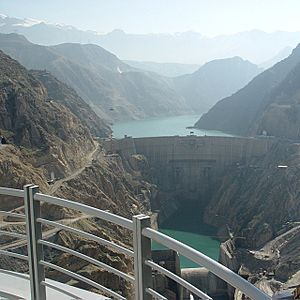List of rivers of Iran facts for kids
Iran is a country in Western Asia with many rivers that are important for its people, farms, and cities. These rivers flow into different large bodies of water or sometimes into special inland basins where the water doesn't reach the ocean. This article will take you on a journey through Iran's main rivers, showing where they go and why they are so important.
Contents
Rivers of Iran: A Watery Journey
Rivers are like the lifelines of a country, providing fresh water for drinking, growing crops, and even generating electricity. In Iran, rivers have played a huge role in shaping history and supporting communities for thousands of years. They help irrigate dry lands, create beautiful natural landscapes, and are home to various plants and animals.
Rivers Flowing into the Persian Gulf
The Persian Gulf is a large sea located between Iran and the Arabian Peninsula. Many of Iran's most important rivers flow into this gulf, especially in the southwestern part of the country. These rivers are vital for agriculture and power generation.
- The Arvand Rud (also known as Shatt al-Arab) is a major river formed by the joining of the Tigris and Euphrates rivers. It forms part of the border between Iran and Iraq.
- The Haffar is a channel that connects the Karun River to the Arvand Rud.
- The Karun River is Iran's most important river, known for its large flow and many dams. These dams help control floods and produce electricity.
- The Marun River and Dez River are important branches that feed into the Karun.
- The Bakhtiari River and Koohrang are smaller rivers that join the Dez.
- The Marun River and Dez River are important branches that feed into the Karun.
- The Tigris River, though mostly in Iraq, has some branches that start in Iran.
-
- The Karkheh River is a long river in Iran that flows into the Tigris system.
- The Seimareh River is a branch of the Karkheh.
- The Sirwan River (also called Diyala River) is another important river that flows from Iran into the Tigris.
- The Alwand River is a tributary of the Sirwan.
- The Little Zab is a river that starts in Iran and flows into the Tigris.
- The Karkheh River is a long river in Iran that flows into the Tigris system.
-
- The Bahmanshir was once the main mouth of the Karun River.
- Other rivers flowing into the Persian Gulf include the Jarahi, Zohreh River, Helleh River, Mond River, Mehran River, and Kul River.
Rivers Flowing into the Gulf of Oman
The Gulf of Oman is located to the southeast of Iran, connecting to the Arabian Sea and the Indian Ocean. Rivers in this region are often seasonal, meaning they might dry up during parts of the year.
- Some of the rivers that flow into the Gulf of Oman are the Dozdan River, Jagin River, Gabrik River, and the Bahu Kalat River (also known as Dashtiari River or Silup River).
Rivers Flowing into Inland Basins
Some rivers in Iran don't reach the ocean. Instead, they flow into special areas called "endorheic basins" or "inland basins." In these basins, the water collects in a lake or a dry salt flat and evaporates, rather than flowing out to sea.
Lake Urmia Basin
Lake Urmia is a large salt lake in northwestern Iran. Many rivers flow into it, but because of climate change and water use, the lake has shrunk significantly.
- Rivers feeding Lake Urmia include the Aji Chay, Zarrineh River, Gadar River, Ghaie River, Alamlou River, Leylan River, Simineh River, Mahabad River, Barandouz River, Shahar River, Nazlou River, Rozeh River, and Zola River.
Caspian Sea Basin
The Caspian Sea is the world's largest inland body of water, often called a sea because of its size and saltwater. It's located north of Iran.
- The Aras River forms part of the border between Iran and several neighboring countries before flowing into the Kura River, which then enters the Caspian Sea.
- The Zangmar River is a tributary of the Aras.
- The Sefīd-Rūd is Iran's second-longest river and flows into the Caspian Sea.
- Its main branches are the Qizil Üzan and Shahrood rivers.
- Other rivers flowing into the Caspian Sea include the Cheshmeh Kileh River, Chaloos River, Kojoor River, Haraz River, Atrek River, and Gharasu River.
Namak Lake Basin
Namak Lake is a salt lake in central Iran. Rivers flowing into it often carry salt, making the lake very salty.
- Rivers in this basin include the Abhar River, Qom River, Jajrood River, and Karaj River.
Gavkhouni Basin
Gavkhouni is a seasonal salt marsh or wetland in central Iran.
- The Zayande River is the most important river flowing into Gavkhouni. It's crucial for the city of Isfahan.
Hamun-e Jaz Murian Basin
Hamun-e Jaz Murian is an inland basin in southeastern Iran.
- The Halil River and Bampur River flow into this basin.
Sistan Basin
The Sistan Basin is a region shared by Iran and Afghanistan, known for its wetlands.
- The Helmand River is a very long river that starts in Afghanistan and flows into the Sistan Basin, providing vital water for both countries. It's important for farming and power.
Hamun-i-Mashkel Basin
- The Mashkid River (also called Mashkel River) flows into this basin.
Karakum Desert Basin
The Karakum Desert is a large desert in Central Asia.
- The Harirud river flows through parts of Iran and Afghanistan before reaching this desert.
- The Kashaf River is a tributary of the Harirud.


